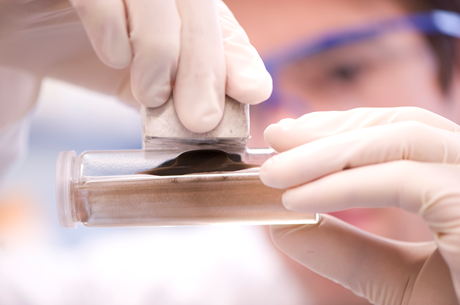Recovery of phosphates from wastewater using superparamagnetic microcomposite particles
Abstract
Microcomposite particles coated with mangnetic ion exchange material can selectively bind phosphates in wastewater, even at low phosphate concentrations. The superparamagnetic properties of the microcomposite particles enable the use of magnetic separation processes with high separation efficiency. They are easy and inexpensive to manufacture and reusable.
See also: “Ministry of Environment publishes studies on recovering phosphates from sewage sludge” (in German):(https://www.lgl-bw.de/lgl-internet/opencms/de/Microsite_EFRE/Aktuelles/Pre ssemitteilung/pressemitteilung_0010.html)
Background
Phosphorus is a chemical element which is needed both in the human body as well as to promote the growth of plants. In industry, phosphorus is used in the form of phosphates, primarily for fertilization in agriculture. On the one hand, phosphorus is a non-renewable resource and, as there are no workable deposits in Germany, it has to be imported. On the other hand, our waters suffer from the contamination caused by phosphates from wastewater.
The magnet particles created during the invention process were developed to simply and economically bind the phosphates from wastewater in order to feed them back into the production cycle, for example in the manufacturing of fertilizers.
Problem
Approaches to recovering phosphates from wastewater have been pursued for some time: These have investigated the use of ion exchange materials (LDHs) for the specific binding of phosphates. The direct use of LDHs (layered double hydroxides) in wastewater, however, causes separation problems, as sedimentation is not possible, and filtering is too complex. A further approach consists in the use of magnetic separation mechanisms. In this case, LDHs are combined with magnet particles and, after a certain time period which is sufficient for the ion exchange, are removed from the wastewater using magnetic separation procedures. However until now, these approaches have been inefficient either due to the necessary processes or due to insufficient results.
Solution
As part of a research project by the Baden-Württemberg Stiftung gGmbH, LDHs are now able to be combined with magnet particles in such a way that the production of the particle and separation from the wastewater are simple and the particles are reusable after recovery of the phosphate. The inventors have realized this by using superparamagnetic nanoparticles. When applying an external magnetic field, these particles show strong magnetic properties, yet after turning off the magnetic field, they do not show any remanent magnetization. The researchers combined these into microcomposite particles, because only in this size is the use of a simple magnetic separation procedure possible. LDHs with high phosphate-binding potential form a shell around the particle. After the phosphate binding has occurred, the particles are isolated using a magnetic separation procedure, the phosphate can then be detached from the LDH shell again, for example through a further ion exchange.
Advantages
- Simple and efficient recovery of phosphates from wastewater
- Time- efficient method for producing magnetic ion exchange materials
- Magnetic separation with very high separation efficiency
- Also effective with low amount of phosphate
- Can be used to recover organic and non-organic ions
Fields of application
Recovery of phosphates from wastewater.
See also: “Ministry of Environment publishes studies on recovering phosphates from sewage sludge” (in German)
(https://www.lgl-bw.de/lgl-internet/opencms/de/Microsite_EFRE/Aktuelles/Pre ssemitteilung/pressemitteilung_0010.html)

